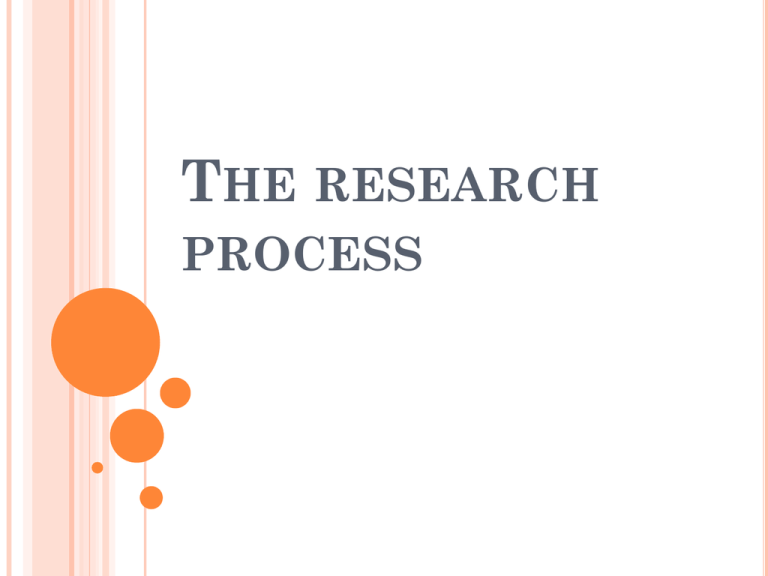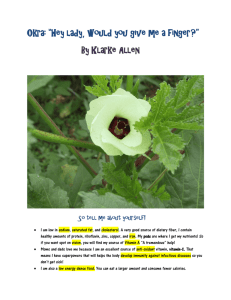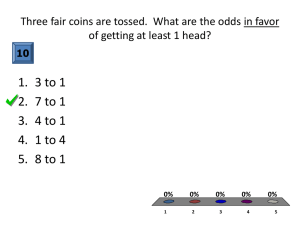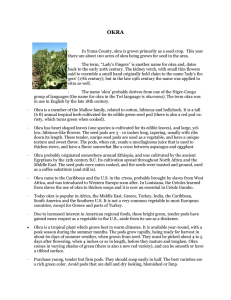
THE RESEARCH
PROCESS
•Identifying the Research Problem
•Formulating Research Problem and
Hypothesis
•Planning the Research Design
Meaning
Research is an endeavor to discover answers to
intellectual and practical problems through the
application of scientific method.
“Research is a systematized effort to gain new
knowledge”.
-Redman and Mory.
Research is the systematic process of
collecting and analyzing information (data) in
order to increase our understanding of the
phenomenon about which we are concerned or
interested.
8.
Formulation
of the
conclusion
1.
Identification
of a research
problem
7. Analysis
and
Interpretation
of processed
data
2.
Formulation
of a
hypothesis
Research Process
6. Data
collection,
organization
and
processing
3. Review of
related
literature
5. Actual
experimentati
on
4. Preparation
of a research
design
STEPS IN THE RESEARCH PROCESS
•Essentially
the same as with the
scientific method
•SCIENTIFIC
METHOD is a sequence of
problem-solving skills that scientists use
in answering questions or problems
IDENTIFICATION
OF RESEARCH
PROBLEM
RESEARCH PROBLEM
What is a research problem?
The
term ‘problem’ means a question or issue to be
examined.
Research Problem refers to some difficulty /need
which a researcher experiences in the context of either
theoretical or practical situation and wants to obtain a
solution for the same.
CHARACTERISTICS OF A GOOD PROBLEM
• A “ researchable” problem is one
that can be investigated through the
collection and analysis of data
• it has theoretical or practical significance.
• It must be a problem that you can
adequately investigate given ;
Your current level of research skill
Available resources
Time and other restrictions
SOURCES OF PROBLEMS
Reading
Academic Experience
Daily Experience
Exposure to Field Situations
Consultations
Brainstorming
Research
Intuition
Checklist of the Guidelines in Selecting a Research Topic
Criteria
1. Is the problem interesting?
2. Will the research contribute to the solution of
socio-economically important problems?
3. Will the research generate new information?
4. Is the research novel?
5. Do I have the skills or knowledge necessary to
conduct the research or can I learn them within the
time I have?
6. Is the research feasible in terms of:
a. Time required to finish the research?
b. Expense involved in conducting the research?
c. Availability of materials?
d. Accessibility of materials?
e. Risks and hazards involved?
7. Is the research reproducible?
Yes/ No
LETS ANALYZE THIS….
In looking for a topic for investigation, a studentresearcher first conducted a survey on the existing
problems in the community. He interviewed
community officials and observed the community.
From the interviews and observations, the following
problems were identified:
• absence of an irrigation system;
• lack of farm-to-market roads;
• abundance of farm pests like locusts and rats;
• laziness of the farmers; and
• high cost of farm inputs particularly fertilizer.
ANALYSIS:
The first two problems are not within the capacity of the
student-researcher to study.
The third problem covers a very wide scope that involves
the simultaneous conduct of many other researches and
requires expertise beyond the ability of the studentresearcher.
The fourth one is a social problem, which is very difficult
for the student-researcher to handle.
Only the last one remains feasible to be worked on.
FORMULATING
RESEARCH
PROBLEM
Characteristics of a Good Research Problem
• clear and unambiguous
• empirical
• verifiable
• interesting
• novel and original
• availability of guidance
For the research problem to be a significant
one, it must
help answer a problem/need of the people/
community/ country;
contribute to the generation of new
information;
develop or improve an existing process; and
contribute to the development of the
scientific skills of the student-researcher.
Example:
Response of Okra to Horse Manure and
Urea: A Comparative Study
Problem:
Compare the effect of horse manure
and urea on the growth of okra.
Statement of
the Problem
•Statement
of the problem must be clear,
organized and specific
•It
must define the scope and limits of the
problem
•It
must identify or specify the variables to
be measured and observed
•It
must set the objectives and goals of the
study
•It
must also state the sub problems
Response of Okra to Horse Manure and
Urea: A Comparative Study
Problem: Compare the effect of horse manure and urea
on the growth of okra.
1. How will the use of horse manure and urea
affect the following:
a. Height of the okra plants?
b. Time of flowering per okra plant?
c. Number of pods per okra plant?
d. Total weight of pods per okra plant?
2. How will the effect of horse manure and
urea on the growth of okra plants differ
in terms of:
a. Average height per plant;
b. Time of flowering per plant;
c. Number of pods per plant;
d. Number of leaves per plant; and
e. Total weight of plants per plot.
The formulated research problem
defines the scope and sets the limits
of the problem.
In the statement of the problem, the
factors/ variables to be observed and
measured must be identified or
specified.
VARIABLES
Anything
that can vary can be considered as a variable.
A variable
is anything that can take on differing or
varying values.
For example; Age, Production units, Absenteeism,
Sex, Motivation, Income, Height, Weight etc.
Note: The values can differ at various times for the
same object or person (or) at the same time for different
objects or persons.
Types of Variables
Explanatory
vs Extraneous Variable
The variables selected for analysis are called explanatory
variables and all other variables that are not related to the purpose
of the study but may affect the dependant variable are extraneous.
Dependant
vs Independent Variable
The variable that changes in relationship to changes in
another variable(s) is called dependant variable.
The variable whose change results in the change in another
variable is called an independent variable.
OR
An independent variable is the one that influences the
dependant variable in either a positive or negative way.
Example:
Response of Okra to Horse Manure
and Urea: A Comparative Study
Independent Variable:
kind of fertilizer used
horse manure
urea
Dependent variable:
Response of okra (growth)
plant height
time of flowering
number of pods
Final weight of the plants
Extraneous variable:
quality of okra seed planted in the
three plots.
sources of the horse manure and
urea
SAMPLE PROBLEM:
Effects of Varying Temperatures and Concentrations on the
Index Refraction of Sugar Solution
OBJECTIVE:
The main objective of the study is to find the effects
of temperature and concentration on the index
refraction of sugar solutions
Specifically, this study seeks to find the effects of (a)
varying temperatures on the index of refraction of
sugar solution, and (b) varying concentrations on the
index of refraction of sugar solution
Reference: Caintic, H.E. Scientific Manual, pp.34-38
Formulating
Hypothesis
FORMULATION OF A HYPOTHESIS
•Hypothesis
serves as a tentative solution to the problem
prior to any experiments
•It
also serves as a guide to the research work plan or design
•It
is tested by conducting the actual experimentation
•Hypothesis
is an educated guess
•It
can be based on factual knowledge, experiences and
observations
•It
can be defined as a possible answer to a problem
A Hypothesis is based on the objectives of
the study. It may be stated in any of the
following forms:
Null form
states that there is no significant difference
between the results of two conditions being
tested.
“There is no significant difference between the effects
of horse manure and urea on the following variables:
average height per plant; time of flowering per plant,
etc.”
Alternative form
States that there is a significant difference
between the results of the two conditions
being tested.
“There is a significant difference between
the effects of horse manure and urea on
the following variables: average height per
plant; time of flowering per plant, etc.”
cause and effect statement
States that if a certain condition (cause) is
true, then a supporting observation (effect)
occurs.
“If there is a difference between the effects of
horse manure and urea, then the growth of
the plants will differ significantly in terms of:
average height per plant, time of flowering
per plant, etc.”
TRY THIS ONE!
Based on the given problem, try to construct your own
hypotheses (null, alternative, cause and effect)
Null Hypothesis
Alternative
Cause and Effect
HypothesisTEMPERATURES
Hypothesis
EFFECTS OF VARYING
AND
CONCENTRATIONS
THE INDEX
OF
1. Varying
1. VaryingON
temperatures
1. IfREFRACTION
temperature is varied,
temperatures
have
have a significant effect then the index of refraction
SUGAR
SOLUTION
no significant effect on the index of
of a sugar solution is
on the index of
refraction of a sugar
affected
refraction of a sugar solution
solution
2. Varying
concentrations have
no significant effect
on the index of
refraction of a sugar
solution
2. Varying
concentrations have a
significant effect on the
index of refraction of a
sugar solution
2. If concentration is varied,
then the index of refraction
of a sugar solution is
affected
Planning the
Research
Design
What is a research design?
a complete sequence of steps
to be fallowed for data
gathering
Provide structure to the
research
Enhance the validity of the
research
The research design is being
prepared to systematize the work
during actual experimentation
Considerations in Making the Design
objectives of the study
Independent variables
Dependent variables
Treatment and control
Subject of the study
Sample groups
Replicate trials
Statistical analysis
Campbell and Stanley Experimental
Design for Research
1. One shot pretest/posttest
Experimental design
T= one test
T1
x= a treatment
X
T2
one group is tested, exposed to a
treatment and then tested again.
applicable in physical sciences
It has no control
How does blanching affect the activity of
enzymes in vegetables?
How does stress affect the strength of
PVC?
What is the effect of a mordant on the
action of a fabric dye?
Randomized control group design
Experimental design:
T1
T1
X
T2
Experimental
T2
Control
this is a standard design for biology
projects.
students compare the pretest (initial
condition) and the posttest (final
condition) with a control group.
the design provides data for the
student’s t-test ( to determine the
difference between sample means) or
for chi-square analysis (for data in
frequency form)
How does electronic radiation
affect the flight of honeybees?
How does calcium affect the
geotropism in plants?
How does zinc affect the
growth of rice?
Variables in series
Experimental design:
T1
T1
T1
Varying
Strengths
Xa
Xb
Varying
treatment
T2
T2
T2
Varying
strengths
Variables is applied in a series of strength,
duration or form.
ANOVA
What is the relationship between the
concentration of fertilizer and the growth
of plants?
What is the effect of solution pH on the
color imparted by a dye?
TYPES OF RESEARCH DESIGN
SINGLE GROUP DESIGN
Composed of only 1 group
CONTROL GROUP
Uses 2 – 3 groups, experimental and the control groups
PARALLEL GROUP DESIGN
3 or more group; 1 experimental and 2 kinds of control
group
COMPLETELY RANDOMIZED DESIGN
Concerns itself with the different effects of treatments
as they are applied randomly on the materials
COMPLETE BLOCK DESIGN
Intended to be used when 2 sets of variables are being
studied
HOW TO CONSTRUCT A SINGLE GROUP DESIGN
Conduct
a pre-test. A pre-test measures the quantity
you're going to test for the experiment. For instance,
imagine an experiment to see if a new drug would cause
weight loss in people who didn't actively exercise. The
pre-test would be to weigh each member and then record
that weight as the value before the experiment happens.
Administer the treatment. If you're giving out a drug
that's supposed to affect weight loss, then administer
the drug in the proper dosage to all participants in the
group. Record who is given how much of the drug and
how often.
Record the results. In this example you would weigh all
of the participants again to see if the their weights
changed.
EXPERIMENTAL PROCEDURE
A good procedure is so detailed and complete that it lets
someone else duplicate your experiment exactly!
Repeating a science experiment is an important
step to verify that your results are consistent and not just
an accident.
For a typical experiment, you should plan to repeat it at
least three times (more is better).
If you are doing something like growing plants, then
you should do the experiment on at least three plants in
separate pots (that's the same as doing the experiment
three times).
KEY ELEMENTS OF THE EXPERIMENTAL
PROCEDURE
Description and size of all experimental and control
groups, as applicable
A step-by-step list of everything you must do to perform
your experiment. Think about all the steps that you will
need to go through to complete your experiment, and
record exactly what will need to be done in each step.
The experimental procedure must tell how you will
change your one and only independent variable and how
you will measure that change
KEY ELEMENTS OF THE EXPERIMENTAL
PROCEDURE
The experimental procedure must explain how
you will measure the resulting change in the
dependent variable or variables
If applicable, the experimental procedure should
explain how the controlled variables will be
maintained at a constant value
The experimental procedure should specify how
many times you intend to repeat your
experiment, so that you can verify that your
results are reproducible.
A good experimental procedure enables someone
else to duplicate your experiment exactly!
PREPARATIONS
Know what to do. Read and understand your
experimental procedure. Are all of the necessary steps
written down? Do you have any questions about how to
do any of the steps?
Get a laboratory notebook for taking notes and
collecting data.
Be prepared. Collect and organize all materials,
supplies and equipment you will need to do the
experiment. Do you have all of the materials you need?
Are they handy and within reach of your workspace?
Think ahead about safety! Are there any safety
precautions you should take? Will you need adult
supervision? Will you need to wear gloves or protective
eye gear? Do you have long hair that needs to be pulled
back out of your face? Will you need to be near a fire
extinguisher?
THANK YOU
FOR
LISTENING!!!!












